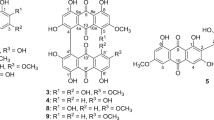Summary
2 yellow naphthoquinone derivatives were isolated from several pathogenic strains ofHendersonula toruloidea Nattrass. They were identified as 2,7-dimethoxy-6-ethyl-5-hydroxy-1,4-naphthoquinone and 2,7-dimethoxy-5-hydroxy-6-(1-acetoxyethyl)-1,4-naphthoquinone by means of physico-chemical methods.
Similar content being viewed by others
References
R. Howe and R.H. Moore, Experientia25, 474 (1969).
R.H. Thomson,Naturally Occurring Quinones, 2nd ed., p. 254. Academic Press, London 1971.
C.K. Campbell and J.L. Mulder, Sabouraudia15, 161 (1977).
Author information
Authors and Affiliations
Additional information
Thanks are due to Mr A.J.M. van Beijnen, Laboratory for Organic Chemistry, State University of Utrecht, for optical rotation measurements.
The authors are indebted to Mr C. Versluys, Analytical Laboratory, State University of Utrecht, for measuring the mass spectra.
We thank Mr J. W. Marsman, Institute for Organic Chemistry TNO, Utrecht, for the PMR-spectra.
Rights and permissions
About this article
Cite this article
van Eijk, G.W., Roeymans, H.J. Naphthoquinone derivatives from the fungusHendersonula toruloidea. Experientia 34, 1257–1258 (1978). https://doi.org/10.1007/BF01981402
Published:
Issue Date:
DOI: https://doi.org/10.1007/BF01981402




